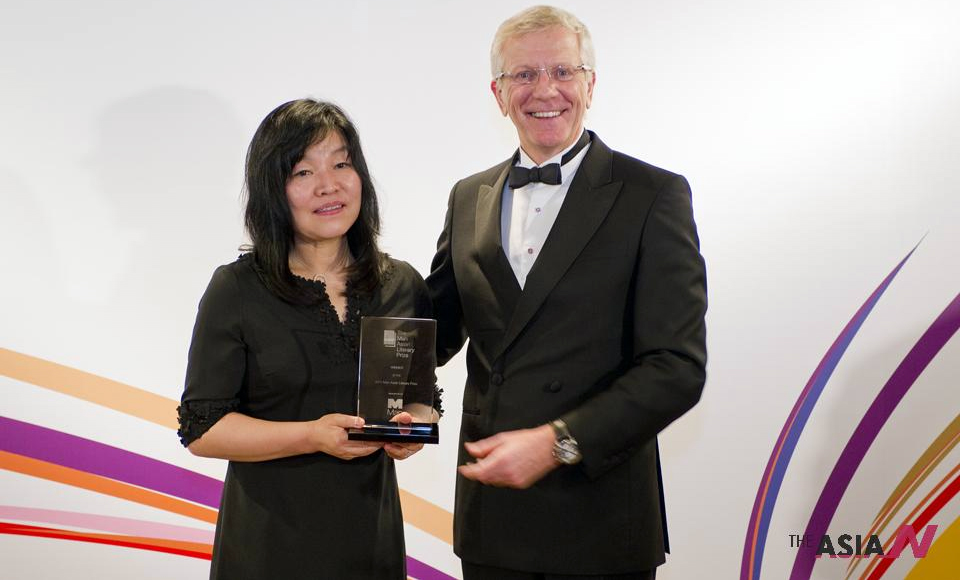زدرافكو بيكار | مد الجسور بين الثقافات
رحلة يوغوسلافية عبر مصر وأفريقيا
بقلم د. آنا س. جاد، صربيا
Zdravko Pečar (Čakovec, 1922 – Rovinj, 1993) was a prominent Yugoslavian figure, diplomat, and journalist. During the period of their most intense activity, Africa was undergoing “astonishingly rapid decolonization,” and the struggle between global blocs was slowly shifting to the continent. In Egypt, Pečar immediately stood out; he was the first foreign journalist to interview General Naguib, the nominal leader of the state, right after the coup. He followed the actions of the new revolutionary government, interviewed President Gamal Abdel Nasser, and was the first photojournalist to photograph Tito on African soil during his visit to Egypt in 1955.
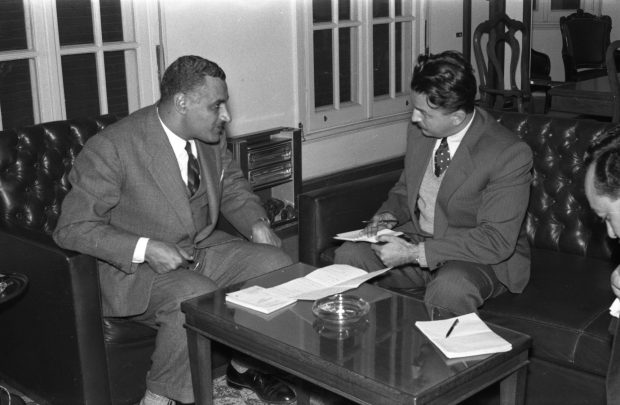
Zdravko Pečar interviewing the President of Egypt, Gamal Abdel Nasser
بمناسبة الذكرى الثلاثين لوفاة الدبلوماسي والصحفي زدرافكو بيكار، استضاف متحف الفن الأفريقي في بلغراد ونظم معرض “زدرافكو بيكار – (AUTO) بورتريهات” يوم 25 مايو، تزامنا مع يوم أفريقيا.
كان زدرافكو بيكار (1922 – 1993) شخصية يوغوسلافية بارزة ودبلوماسيا شهيرا وصحافيا ماهرا. انضم خلال الحرب العالمية الثانية عضوا لهيئة تحرير صحيفة “نابريجد” (إلى الأمام) وبعد التحرير عمل محررا في صحيفة “بوليتيكا” (السياسة) ورئيس تحرير صحيفة “ميدونارودن بوليتيكا”، (السياسة الدولية) ومراسلا لقناة “بوربا” (المعركة أو النضال) من مصر وعدة دول إفريقية أخرى. وفي معهد دراسة الحركة العمالية، عمل باحثًا مستقلاً من عام 1963 إلى عام 1967.
كصحفي وناشط إعلامي، نشر العديد من المقالات والمناقشات في العلاقات الدولية والسياسة. منذ عام 1967، خدم في مناصب دبلوماسية. كما حصل بيكار على العديد من الأوسمة اليوغوسلافية والأجنبية. تزوج من فيدا زاغوراتش، وأسس معها متحف الفن الأفريقي في بلجراد، الذي افتتح في مايو 1977.

Zdravko Pečar at Abu Simbel
كانت لدى بيكار عاطفة عميقة تجاه أفريقيا، وتركت ثقافة القارة السمراء بصمة لا تمحى على حياته. وقد زار مع زوجته فيدا العديد من الدول الأفريقية، بما في ذلك مصر والجزائر وتونس وغانا ومالي. وفي دراسته الأساسية “إفريقيا”، التي يصف فيها تجاربه في القارة، كتب بيكار:

Zdravko Pečar on a camel in front of the Giza pyramids
“إن الطبول تدق بالفعل ناقوس الخطر من كوناكري إلى أكرا، على طول الطريق إلى جنوب أفريقيا، ولكن يبدو أن البيض لا يريدون سماع ذلك”.
كان هذا الخطاب القوي المناهض للاستعمار، والذي تجاوز الحدود الاستعمارية ودعم النضال التحرري للشعوب الأفريقية، جزءًا ثابتًا وبارزًا من نصوص وأفعال وآراء كل من فيدا زاغوراتش وزدرافكو بيكار.
خلال فترة فورتها وثورتها الأكثر كثافة، كانت أفريقيا تمر “بعملية إنهاء الاستعمار السريعة إلى حد مذهل”، وكان الصراع بين الكتل العالمية يتحول ببطء إلى القارة. في مصر، برز بيكار على الفور؛ وكان أول صحافي أجنبي أجرى مقابلة مع اللواء محمد نجيب، الزعيم الاسمي للدولة، مباشرة بعد الانقلاب. ثم تابع تحرك الحكومة الثورية الجديدة، وأجرى مقابلة مع الرئيس جمال عبد الناصر، وكان أول مصور صحفي يصور تيتو على الأراضي الأفريقية أثناء زيارته لمصر عام 1955.
كما أنتج العمل المشترك بين زدرافكو بيكار وفيدا زاجوراك أول دراسة عن مصر في يوغوسلافيا، بعنوان “مصر الجمهورية”، نُشرت في عام 1955. وبعد ثلاث سنوات، توسع هذا النص ليصبح دراسة أساسية “مصر: أرض – شعب – ثورة”. يُعتقد أن مساهمات فيدا ركزت على الاقتصاد والثقافة والمجتمع، بينما كتب زدرافكو عن السياسة والجيش والتاريخ. في عام 1957، نشر بيكار كتاب “ماذا يحدث في الشرق الأوسط”.
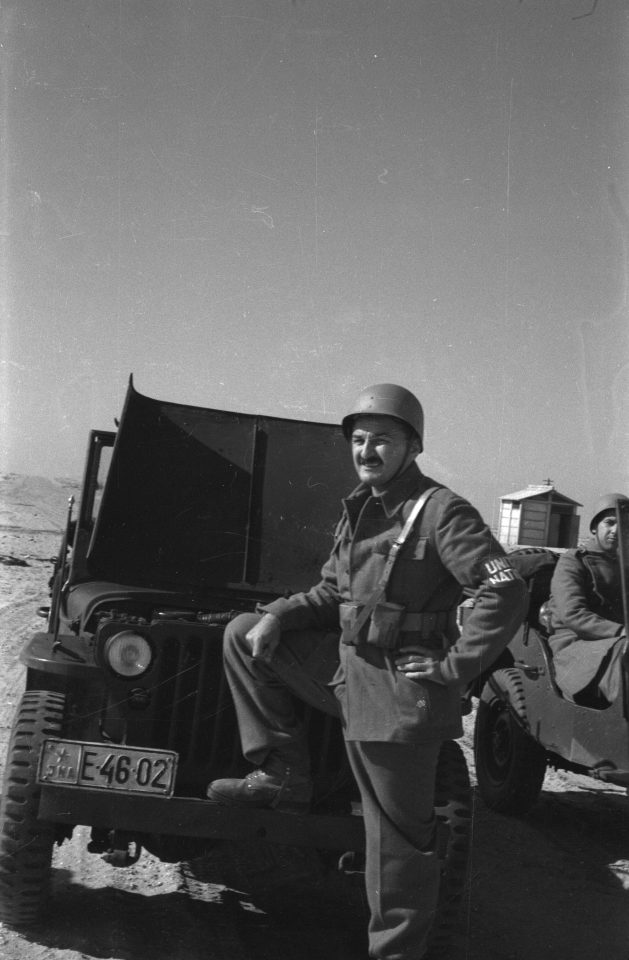
Zdravko Pečar with UN forces in Sinai during the Suez Crisis
بدأت رحلة بيكار الأكثر شمولاً عبر إفريقيا في عام 1959، حيث التقى خلالها بقادة بارزين في تحرير إفريقيا، بما في ذلك باتريس لومومبا، وكوامي نكروما، وهولدن روبرتو، وليوبولد سيدار سنجور، وجوليوس نيريري، وهاستينجز كاموزو باندا.
في عام 1964، دافع زدرافكو بيشار عن أطروحته “تاريخ النضال التحريري للشعب الجزائري” في كلية الفلسفة، وحولها فيما بعد إلى دراسة “الجزائر حتى الاستقلال”، وقدم كتاباه – “إفريقيا” (1964) و”الحركات الأفريقية” (1965) – الأفكار الأكثر شمولاً حول إنهاء الاستعمار في أفريقيا، والتي استخدمها الباحثون في يوغوسلافيا لعقود من الزمن.
يمثل زدرافكو بيكار شخصية استثنائية في الثقافة اليوغوسلافية، حيث عاش حياة مليئة بالمغامرات. قضى جزءًا كبيرًا من حياته في أفريقيا، كصحفي ودبلوماسي، تاركًا وراءه مجموعة قيمة من القطع الفنية وأرشيفًا شخصيًا للصور، ورثه لمتحف الفن الأفريقي.
في عام 1988، قبل سنوات قليلة من وفاته، تم انتخاب بيكار عضوًا فخريًا في رابطة الأفارقة اليوغوسلافيين ومثل أرشيفه لمتحف الفن الأفريقي تراثًا ثقافيًا قيمًا لكل من بلجراد وصربيا.وتوفي الصحفي والسفير زدرافكو بيكار عام 1993 في مدينة روفيني، كرواتيا الحالية.
Zdravko Pečar: Bridging Cultures – A Yugoslav Journey Through Egypt and Africa
On the occasion of the 30th anniversary since the death of diplomat and journalist Zdravko Pečar, the Museum of African Art in Belgrade hosted and organized the exhibition “Zdravko Pečar – (AUTO)PORTRAITS” on May 25th, coinciding with Africa Day.
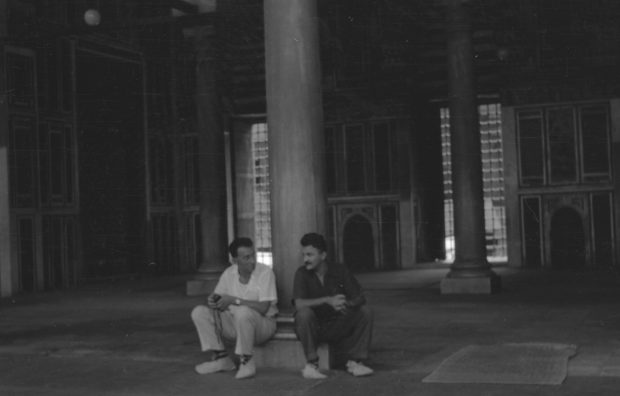
Zdravko Pečar sitting with an Egyptian inside a mosque in Cairo
Zdravko Pečar (Čakovec, 1922 – Rovinj, 1993) was a prominent Yugoslavian figure, diplomat, and journalist. During World War II, he was a member of the editorial staff of the newspaper “Naprijed,” (Forward) and after the liberation, he served as an editor for “Politika,” (meaning Politics) the chief editor of “Međunarodna Politika,” (meaning International Politics) and a correspondent for “Borba” (meaning Battle or Struggle) from Egypt and several other African countries. At the Institute for the Study of the Labor Movement, he was an independent researcher from 1963 to 1967. As a journalist and publicist, he published numerous articles and discussions in international relations and politics. Since 1967, he served in diplomatic roles.
Pečar was the recipient of numerous decorations, both Yugoslav and foreign. He was married to Veda Zagorac, with whom he founded the Museum of African Art in Belgrade, which opened in May 1977.
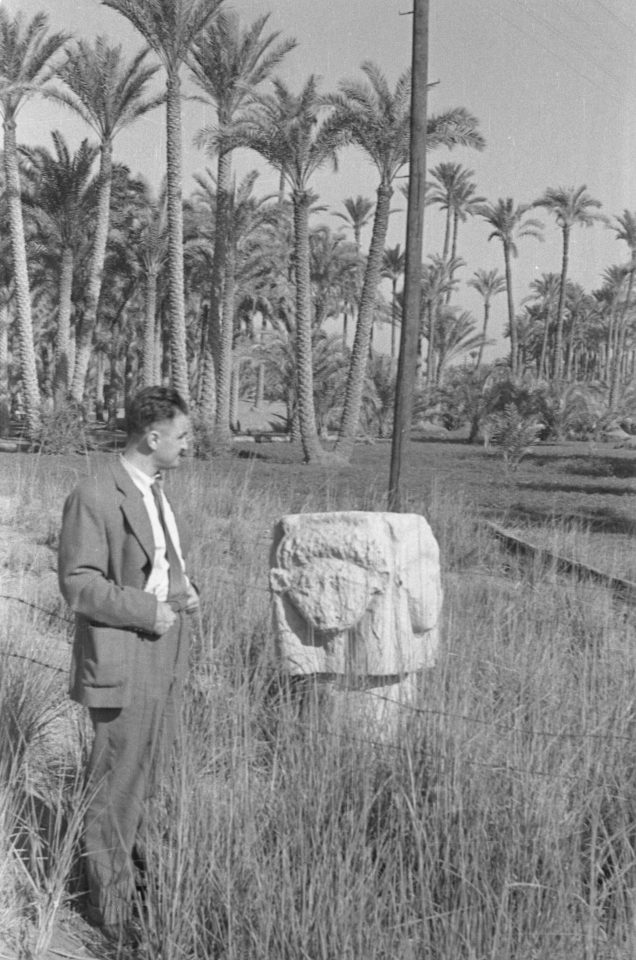
Zdravko Pečar next to a Hathor column in a filed in Egypt
Pečar had a profound affection for Africa, and the continent’s culture left an indelible mark on his life. Along with his wife Veda, he visited many African countries, including Egypt, Algeria, Tunisia, Ghana, and Mali. In his seminal monograph “Africa,” describing his experiences on the continent, Pečar wrote: “The drums are already calling for alarm from Conakry to Accra, all the way to the south of Africa, but the white people seem not to want to hear them.” This strong anti-colonial discourse, crossing colonial boundaries and supporting the liberation struggle of African peoples, was a constant and prominent part of the texts, actions, and opinions of both Veda Zagorac and Zdravko Pečar.
During the period of their most intense activity, Africa was undergoing “astonishingly rapid decolonization,” and the struggle between global blocs was slowly shifting to the continent. In Egypt, Pečar immediately stood out; he was the first foreign journalist to interview General Naguib, the nominal leader of the state, right after the coup. He followed the actions of the new revolutionary government, interviewed President Gamal Abdel Nasser, and was the first photojournalist to photograph Tito on African soil during his visit to Egypt in 1955.
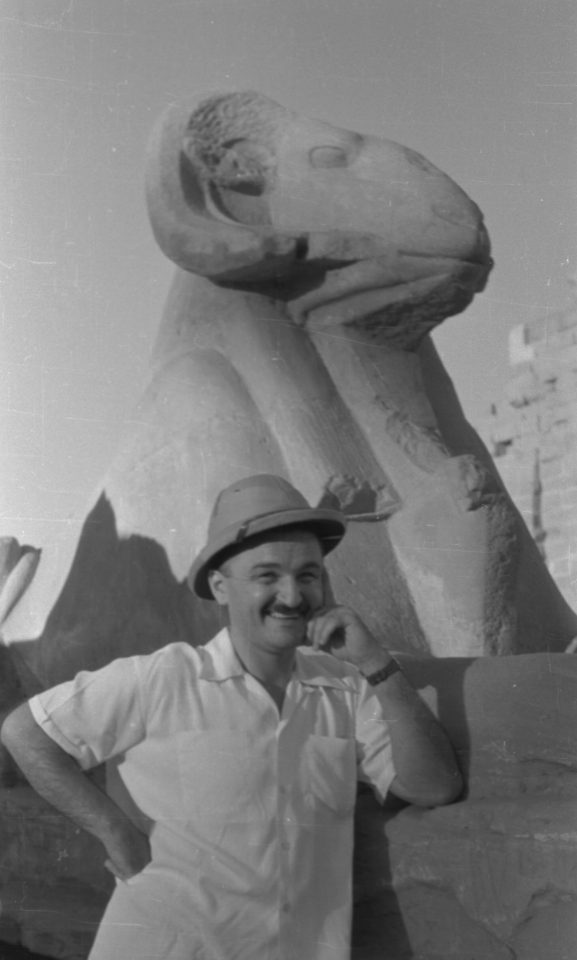
Zdravko Pečar next to one of the sphinx in the Avenue of Sphinx outside of Karnak
The joint work of Zdravko Pečar and Veda Zagorac also produced the first monograph on Egypt in Yugoslavia, “Republican Egypt,” published in 1955. Three years later, this text expanded into the seminal monograph “Egypt: Land – People – Revolution.” It is believed that Veda’s contributions focused on the economy, culture, and society, while Zdravko wrote about politics, the military, and history. In 1957, Pečar published the book “What’s Happening in the Middle East.”
Pečar’s most extensive journey across Africa began in 1959, during which he met with significant leaders of African liberation, including Patrice Lumumba, Kwame Nkrumah, Holden Roberto, Léopold Sédar Senghor, Julius Nyerere, and Hastings Kamuzu Banda.
In 1964, Zdravko Pečar defended his dissertation “The History of the Algerian People’s Liberation Struggle” at the Faculty of Philosophy, later transforming it into the monograph “Algeria until Independence.” His books “Africa” (1964) and “African Movements” (1965) offered the most comprehensive insights into African decolonization, utilized by researchers in Yugoslavia for decades.
Zdravko Pečar was an exceptional figure in Yugoslav culture, leading an extraordinarily adventurous life. He spent a significant part of his life in Africa, both as a journalist and diplomat, leaving behind a valuable collection of art objects and a personal photo archive, bequeathed to the Museum of African Art. In 1988, a few years before his death, Pečar was elected an honorary member of the Association of Yugoslav Africanists and left his archive to the Museum of African Art, representing a valuable cultural heritage for both Belgrade and Serbia.
The journalist and ambassador Zdravko Pečar passed away in 1993 in Rovinj, present-day Croatia.
لي جون سوك: الأولوية للأمن القومي؛ الاقتصاد؛ والتعليم
مؤسس جمعية الصحفيين الآسيويين، ناشر (آسيا إن)، كوريا الجنوبية
ثقافة الباعة الجائلين بسنغافورة تدخل تراث اليونسكو

الرئيس الشرفي لجمعية الصحفيين الآسيويين، صحفي مخضرم من سنغافورة
لغة الأشياء / أروى ومصباح الأمنيات
روائية وقاصة من الكويت، فازت بجائزة الدولة التشجيعية، لها عمود أسبوعي في جريدة (الراي) الكويتية.
كوريا الشمالية: الأسرة والزواج وأشياء أخرى!

آندريه نيكولايفيتش لانكوف Andrei Nikolaevich Lankov![]()
كاتب روسي حاصل على درجة الدكتوراه في التاريخ من جامعة الدولة في ليننجراد ، درس في جامعة كيم إل ـ سونج، أستاذ في الجامعة الأسترالية الوطنية وجامعة كوكمين.































